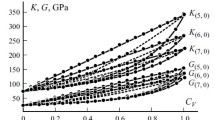Abstract
In this work, a new multi-coated inclusion model to determine the effective thermal conductivity of reinforced composite materials is developed. The methodology is based on Green’s functions technique and integral equation which gives the local thermal fields through concentration equations in each phase of the composite-inclusion. The solution is presented within the general framework of anisotropic thermal behavior of the phases and ellipsoidal inclusions. The effective behavior of multi-coated inclusion-reinforced material is determined within a ‘\((N+1)\)-phase’ Generalized Self-Consistent Scheme. To assess the present model’s reliability, some comparisons with other micromechanical models and exact solutions are presented for different inclusions’ morphologies. The model is applied to two-phase materials, and the results are compared to bounds established for ellipsoidal shape. Some results for three-phase materials are given regarding the influence of the thermal contrast between phases and the shape of inclusions.









Similar content being viewed by others
References
Markov, K.Z.: Elementary micromechanics of heterogeneous media. In: Markov, K.Z., Preziozi, L. (eds.) Heterogeneous Media. Micromechanics Modeling Methods Simulations, pp. 1–162. Birkhauser, Boston (2000)
Sevostianov, I., Kachanov, M.: Connections between elastic and conductive properties of heterogeneous materials. In: Van der Giessen, E., Aref, H. (eds.) Adv. Appl. Mech., pp. 59–252. Academic Press, London (2009)
Eshelby, J.D.: The determination of the elastic field of an ellipsoidal inclusion, and related problems. Proc. R. Soc. Lond. A 241, 376–396 (1957)
Fricke, H.: A mathematical treatment of the electric conductivity and capacity of disperse systems. I: The electric conductivity and capacity of disperse systems. Phys. Rev. 24, 575–587 (1924)
Hatta, H., Taya, M.: Equivalent inclusion method for steady state heat conduction in composites. Int. J. Eng. Sci. 24, 1159–1172 (1986)
Sevostianov, I., Kachanov, M.: Explicit cross-property correlations for anisotropic two-phase composite materials. J. Mech. Phys. Solids 50, 253–282 (2002)
Aboudi, J., Arnold, S.M., Bednarcyk, B.A.: Micromechanics of composite materials: a generalized multiscale analysis approach. Butterworth-Heinemann, Oxford (2012)
Christensen, R.M.: Viscoelastic properties of heterogeneous media. J. Mech. Phys. Solids 17, 23–41 (1969)
Christensen, R., Lo, K.: Solutions for effective shear properties in three phase sphere and cylinder models. J. Mech. Phys. Solids 27, 315–330 (1979)
Kerner, E.H.: The electrical conductivity of composite media. Proc. Phys. Soc B 69, 802–807 (1956)
Hashin, Z.: Assessment of the self consistent approximation: conductivity of particulate composites. J. Compos. Mater. 2, 284–300 (1968)
Maxwell, J.C.: A Treatise on Electricity and Magnetism, vol. 1. Clarendon, Oxford (1873)
Herve, E.: Thermal and thermoelastic behaviour of multiply coated inclusion-reinforced composites. Int. J. Solids Struct. 39, 1041–1058 (2002)
Yang, R., Lee, Y., Shiah, Y.C., Tsai, T.: On the generalized self-consistent model for the effective thermal conductivity of composites reinforced by multi-layered orthotropic fibers. Int. Commun. Heat Mass Transf. 49, 55–59 (2013)
Giordano, S.: Nonlinear effective behavior of a dispersion of randomly oriented coated ellipsoids with arbitrary temporal dispersion. Int. J. Eng. Sci. 33, 1–22 (2015)
Hatta, H., Taya, M.: Thermal conductivity of coated filler composites. J. Appl. Phys. 59, 1851–1860 (1986)
Felske, J.D.: Effective thermal conductivity of composite spheres in a continuous medium with contact resistance. Int. J. Heat Mass Transf. 47, 3453–3461 (2004)
Lee, Y.-M., Yang, R., Gau, S.: A generalized self-consistent method for calculation of effective thermal conductivity of composites with interfacial contact conductance. Int. Commun. Heat Mass Transf. 33, 142–150 (2006)
Sevostianov, I., Kachanov, M.: Effect of interphase layers on the overall elastic and conductive properties of matrix composites. Applications to nanosize inclusion. Int. J. Solids. Struct. 44, 1304–1315 (2007)
Benveniste, Y., Chen, T., Dvorak, G.J.: The effective thermal conductivity of composites reinforced by coated cylindrically orthotropic fibers. J. Appl. Phys. 67, 2878–2884 (1990)
Hori, M., Nemat-Nasser, S.: Double-inclusion model and overall moduli of multi-phase composites. Mech. Mater. 14, 189–206 (1993)
Kim, S.Y., Noh, Y.J., Yu, J.: Prediction and experimental validation of electrical percolation by applying a modified micromechanics model considering multiple heterogeneous inclusions. Compos. Sci. Technol. 106, 156–162 (2015)
Yu, S., Yang, S., Cho, M.: Multiscale modeling of cross-linked epoxy nanocomposites to characterize the effect of particle size on thermal conductivity. J. Appl. Phys. 110, 124302 (2011)
Dinzart, F., Sabar, H., Berbenni, S.: Homogenization of multi-phase composites based on a revisited formulation of the multi-coated inclusion problem. Int. J. Eng. Sci. 100, 136–151 (2016)
Mura, T.: Micromechanics of Defects in Solids, Section 22. Kluwer Academic Publishers, Dordrecht (1987)
Calvo-Jurado, C., Parnell, W.J.: Hashin–Shtrikman bounds on the effective thermal conductivity of a transversely isotropic two-phase composite material. J. Math. Chem. 53, 828–843 (2015)
Benveniste, Y.: Models of thin interphases and the effective medium approximation in composite media with curvilinearly anisotropic coated inclusions. Int. J. Eng. Sci. 72, 140–154 (2016)
Author information
Authors and Affiliations
Corresponding author
Additional information
Publisher's Note
Springer Nature remains neutral with regard to jurisdictional claims in published maps and institutional affiliations.
Rights and permissions
About this article
Cite this article
Dinzart, F., Jeancolas, A., Bonfoh, N. et al. Micromechanical modeling of the multi-coated ellipsoidal inclusion: application to effective thermal conductivity of composite materials. Arch Appl Mech 88, 1929–1944 (2018). https://doi.org/10.1007/s00419-018-1418-2
Received:
Accepted:
Published:
Issue Date:
DOI: https://doi.org/10.1007/s00419-018-1418-2




